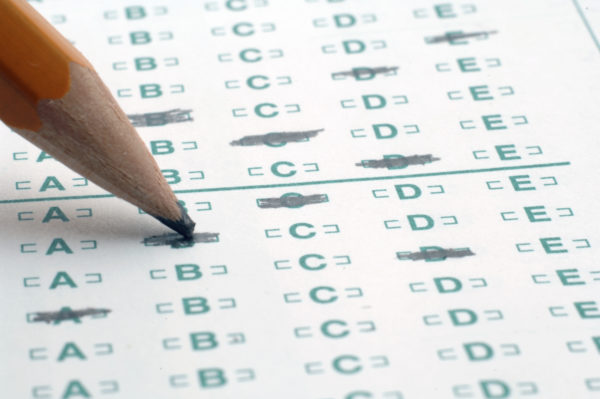College Readiness Exams Measure the Wrong Things

Testing sheet/PBS
by Zara Kornfeld
America’s tool for measuring college readiness is failing us, and Nyack is not immune.
For those who need a reminder, the SAT consists of four parts: reading, writing, math (with and without a calculator), and the essay. The ACT adds on a science comprehension section, and its math section allows the student to use a calculator for its entirety. However, both tests have one thing in common: both claim to gauge college readiness. ACT inc reports that over 60% of people who took the ACT in 2016 reached the college benchmark. So then why do 60% of those students, upon attending college, get placed in remedial classes despite how they placed on their standardized test? There is obviously a missing link between what the standardized tests are testing for and actual college readiness. What’s wrong with these tests is that they can’t seem to accurately predict the one thing which they are put in place to measure.
A major issue with these tests is that more than measuring college readiness, they measure financial stability. While this may not be an intended result, students from households which earn less than $20,000 per year on average scored around 400 points lower on the 2014 SAT than students from households which made $200,000 per year. In 2007, the highest average SAT scores in Rockland County were from the Clarkstown Central School District. The average income per household in 2015 for Clarkstown was $103,151. Compare this to the lowest SAT scores of that year (around 300 points lower than Clarkstown) which came from the East Ramapo Central School District, which had an average household income of $45,613 in 2015.
(adsbygoogle = window.adsbygoogle || []).push({});
The correlation between household income and college readiness scores might have something to do with the $2.5 billion spent inside of the test preparatory system in 2009 alone. Hailey Raab, a Nyack High School senior planning to attend University of Michigan in the fall, estimated that she spent “at least five hours a week” preparing for the tests, and that having access to a tutor made a definite difference in her score. “The tutor taught me things that studying from a book couldn’t, especially with the writing,” she said.
Hailey’s experience is very familiar to many high school students. The National Center for Fair and Open Testing says the tests are “highly coachable, advantaging students who can afford to spend $800 or more on test preparation classes.” Nyack’s average 2007 SAT scores are around 100 points lower than Clarkstown’s and 200 points higher than East Ramapo’s. Nyack’s $64,872 average income per household in 2015 reflects that point. The correlation between income and test scores implies that students attempting to prove their readiness for college through these tests will be seen through a different light according to their financial background.
 The Problem Transcends Class: ACTs and SATs are Racially Biased
The Problem Transcends Class: ACTs and SATs are Racially Biased
And not only do standardized tests show their bias financially, they show it racially too. On average, black and Hispanic students do significantly worse than white and Asian students. Nyack has a white majority, with 58% of its residents being Caucasian. Clarkstown is 67% white, while Spring Valley is 40% black and 30% Hispanic. The town’s scores and white populations correlate, and this problem is by no means isolated to Rockland.
The cause of the correlation is heavily debated. Some have cited lower income and less affluent areas as the cause for the lower test scores. Christopher Jencks and Meredith Phillips, authors of The Black-White Test Score Gap, argue that the gap exists because of the parent’s attitude towards education. No matter the reason, even on standardized tests besides the ACT and SAT, the system shows its bias. In 2015, 99% of white students in Nyack proved proficient in English at the end of their high school careers, while the same can be said for only 80% of black students and only 72% of Hispanic students. On the same test, 94% of economically stable students proved proficient compared to only 79% of financially unstable students. There is a terrifying pattern that tells college admission counselors that black, Hispanic, and less affluent students are less qualified for college. Harvard’s class of 2020 is only 13.7% African-American; Yale is only 7.6%. Hispanic students comprise 12.8% and 12.6% at Yale and Harvard, respectively.
A Model for Schools to Follow
Not all hope is lost, though.
Schools like Hampshire College completely banned applicants’ submitting standardized test scores in 2014. They claimed, among other reasons, that “some good students are bad test takers, particularly under stress, such as when a test may grant or deny college entry; multiple-choice tests don’t reveal much about a student.” As a result of this change, they claim, “class diversity increased to 31% students of color, the most diverse in our history, up from 21% two years ago.” But if standardized tests aren’t the answer, then how are schools supposed to measure college readiness in applicants?
Hampshire College believes high school GPA gives a more accurate depiction of college readiness, as it shows a student’s work over their entire high school careers instead of being based on one day. They also have put in place a system in which recommendation letters and writing supplements are used in order to put admissions counselors “in a much better position to predict their likelihood of success [at Hampshire]”.
Tamara Russell, a mixed race Nyack High School senior found a way to avoid the standardized testing system all together by starting her two years at SUNY Rockland in her senior year of high school. She plans to transfer to a four year university once she’s gained an Associate’s degree. In this case, schools don’t have to look at a predictor test, because they can simply look at her actual grades. “ I went to RCC because I knew it would save money, time and help me avoid having to rely on those test scores to get into college,” she said.
The National Center for Fair and Open Testing is in agreement that GPA should be looked at as the best measurement of predicting college readiness. And Bates College reports that, “students who had strong high school GPAs performed well in college regardless of their lower standardized test scores,” which makes sense considering college itself isn’t simply one big test.
Additionally, many students have entered remedial college classes because a test told them that is where they belonged. But the data clearly shows, “Up to one-third of students were found to be ‘severely misassigned’ using placement-test results, and that error rate could be reduced in half by using high-school grades instead of test scores.” Besides the extra thousands of dollars spent on an unnecessary courses which yield no credits, it was found by the Chronicle of Higher Education that students placed in remedial courses were actually less likely to graduate from college. Therefore, on this particular level of standardized testing, these assessments are not only hindering students’ capabilities, but hurting their futures as well. If this is the case, why are colleges still even having “test optional” as an option?
Few know. College Board and ACT Inc. can be seen defending themselves with little support. In a piece put out by ACT, they attempt to show the advantages of their system by “providing better and more relevant data to students, parents, schools, districts, and states.” However, the data shows that Black, Hispanic, and lower income students are often misrepresented. ACT’s response to some of these groups is simply that, “the number of underserved students taking the ACT test has increased significantly since 2012, most dramatically among Hispanic students (up by 44%) and African American students (up by 23%).”
It is not an acceptable explanation to simply say that because your test says that these students are not ready for college, that it means that they are not ready for college. The problem here is lack of evidence and a surplus of authority. ACT and College Board are the only suppliers of the tests, and because many colleges them, they become the only authority families can listen to. The testing system, as organizations such as Americans for Educational Testing Reform (AETR) have realized, is more or less a monopoly.
If colleges truly do want a measure of college readiness, they would do best to look away from the cold numbers of standardized tests, and take a deeper look at the student.
Zara Kornfeld is a senior at Nyack High School.








